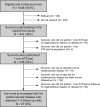Reduced Lower Body Muscular Strength and Endurance among Adult Survivors of Childhood Cancer
- PMID: 39809246
- PMCID: PMC11801469
- DOI: 10.1249/MSS.0000000000003593
Reduced Lower Body Muscular Strength and Endurance among Adult Survivors of Childhood Cancer
Abstract
Introduction: Impaired physical fitness is a possible late effect among adult survivors of childhood cancer (ASCC). Our study describes lower body muscular strength and endurance among ASCC using the 1-min sit-to-stand (1-min STS) test, compares them with the general population, identifies risk factors, and describes changes over time.
Methods: In a prospective multicenter cohort study, we invited ASCC ≥18 yr of age at study who were diagnosed between ages 0 and 20 yr, treated in five pediatric oncology centers across Switzerland from 1976 to 2017, and survived ≥5 yr for a 1-min STS test. We collected information about lifestyle, medical history, and previous cancer treatment. Using population-based Swiss reference values, we calculated age- and sex-adjusted z -scores for 1-min STS performance and assessed the association between risk factors and 1-min STS test using multivariable linear regression. We fitted a multilevel linear model to describe the longitudinal course of 1-min STS performance.
Results: We included 338 CCS of 1048 invited ASCC (participation rate 32%) with a median age at study of 34 yr (interquartile range, 26-41 yr). Compared with the general population, mean 1-min STS z -score was half a standard deviation lower (-0.52; 95% confidence interval (CI), -0.64 to -0.40). Obesity ( B = -0.56; 95% CI, -0.97 to -0.16), cumulative cisplatin dose ( B = -0.12; 95% CI, -0.21 to -0.02), and cumulative cranial radiotherapy dose ( B = -0.10; 95% CI, -0.19 to -0.01) were associated with reduced 1-min STS performance. There was no change in 1-min STS z -scores over time ( B = 0.02; 95% CI, -0.05 to 0.09).
Conclusions: We found evidence for reduced lower body strength and endurance among ASCC, suggesting the need for counseling and effective training and rehabilitation programs for maintaining daily functioning, improving cardiovascular health, and reducing morbidity for ASCC.
Copyright © 2024 The Author(s). Published by Wolters Kluwer Health, Inc. on behalf of the American College of Sports Medicine.
Figures



Similar articles
-
Prevalence and factors associated with cancer-related fatigue in Swiss adult survivors of childhood cancer.J Cancer Surviv. 2024 Feb;18(1):135-143. doi: 10.1007/s11764-023-01413-1. Epub 2023 Jun 13. J Cancer Surviv. 2024. PMID: 37312001 Free PMC article.
-
Population-based reference values for the 1-min sit-to-stand test.Int J Public Health. 2013 Dec;58(6):949-53. doi: 10.1007/s00038-013-0504-z. Epub 2013 Aug 24. Int J Public Health. 2013. PMID: 23974352
-
Physical fitness and modifiable cardiovascular disease risk factors in survivors of childhood cancer: A report from the SURfit study.Cancer. 2021 May 15;127(10):1690-1698. doi: 10.1002/cncr.33351. Epub 2021 Jan 6. Cancer. 2021. PMID: 33405260
-
Muscle morphology and performance in master athletes: A systematic review and meta-analyses.Ageing Res Rev. 2018 Aug;45:62-82. doi: 10.1016/j.arr.2018.04.007. Epub 2018 Apr 30. Ageing Res Rev. 2018. PMID: 29715523
-
Early and late adverse renal effects after potentially nephrotoxic treatment for childhood cancer.Cochrane Database Syst Rev. 2019 Mar 11;3(3):CD008944. doi: 10.1002/14651858.CD008944.pub3. Cochrane Database Syst Rev. 2019. PMID: 30855726 Free PMC article.
Cited by
-
Sit to stand is a new reliable method for assessing strength, power, and velocity exercise in adult pediatric cancer survivors.J Cancer Res Clin Oncol. 2025 Jun 14;151(6):189. doi: 10.1007/s00432-025-06225-7. J Cancer Res Clin Oncol. 2025. PMID: 40514602 Free PMC article.
References
-
- Hovi L, Era P, Rautonen J, Siimes MA. Impaired muscle strength in female adolescents and young adults surviving leukemia in childhood. Cancer. 1993;72(1):276–81. - PubMed

